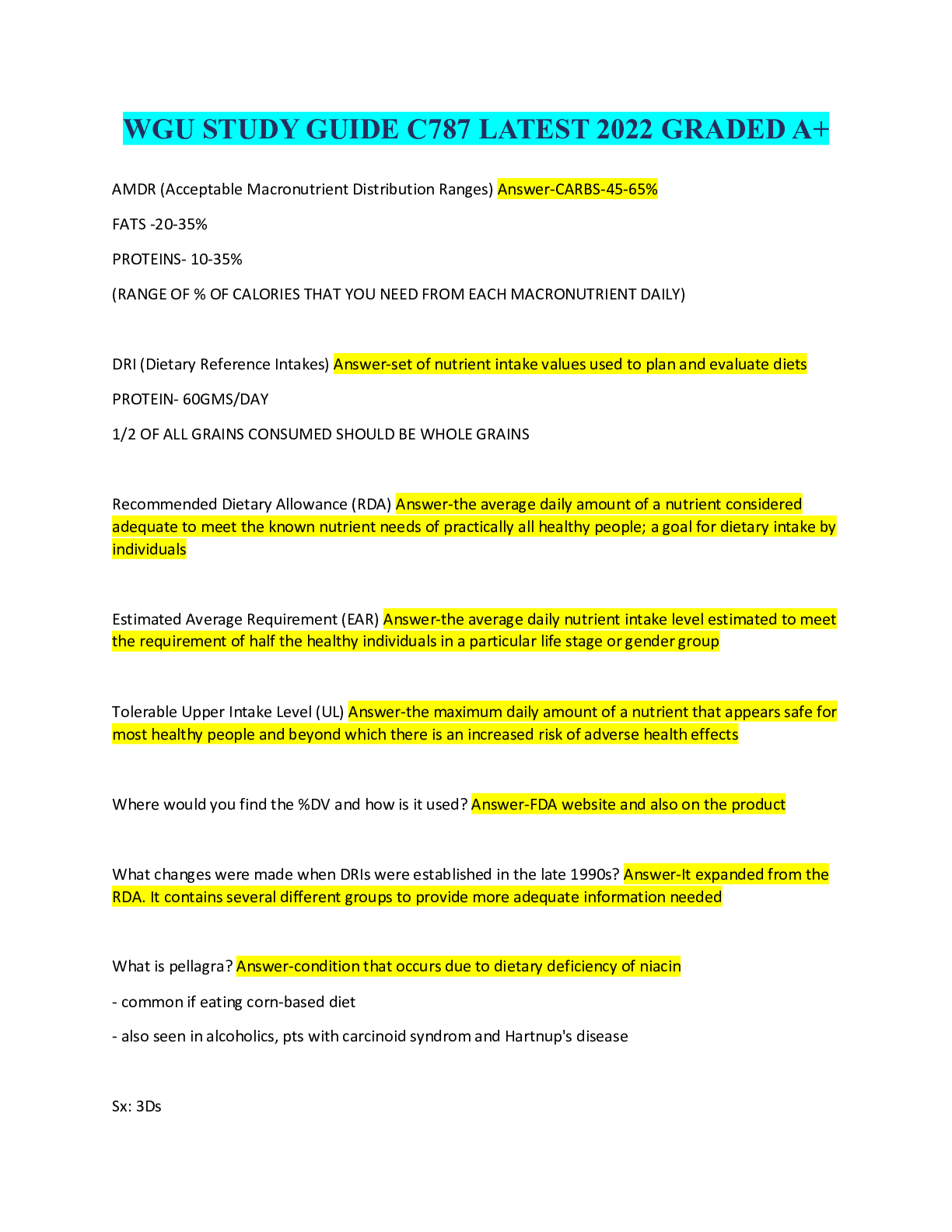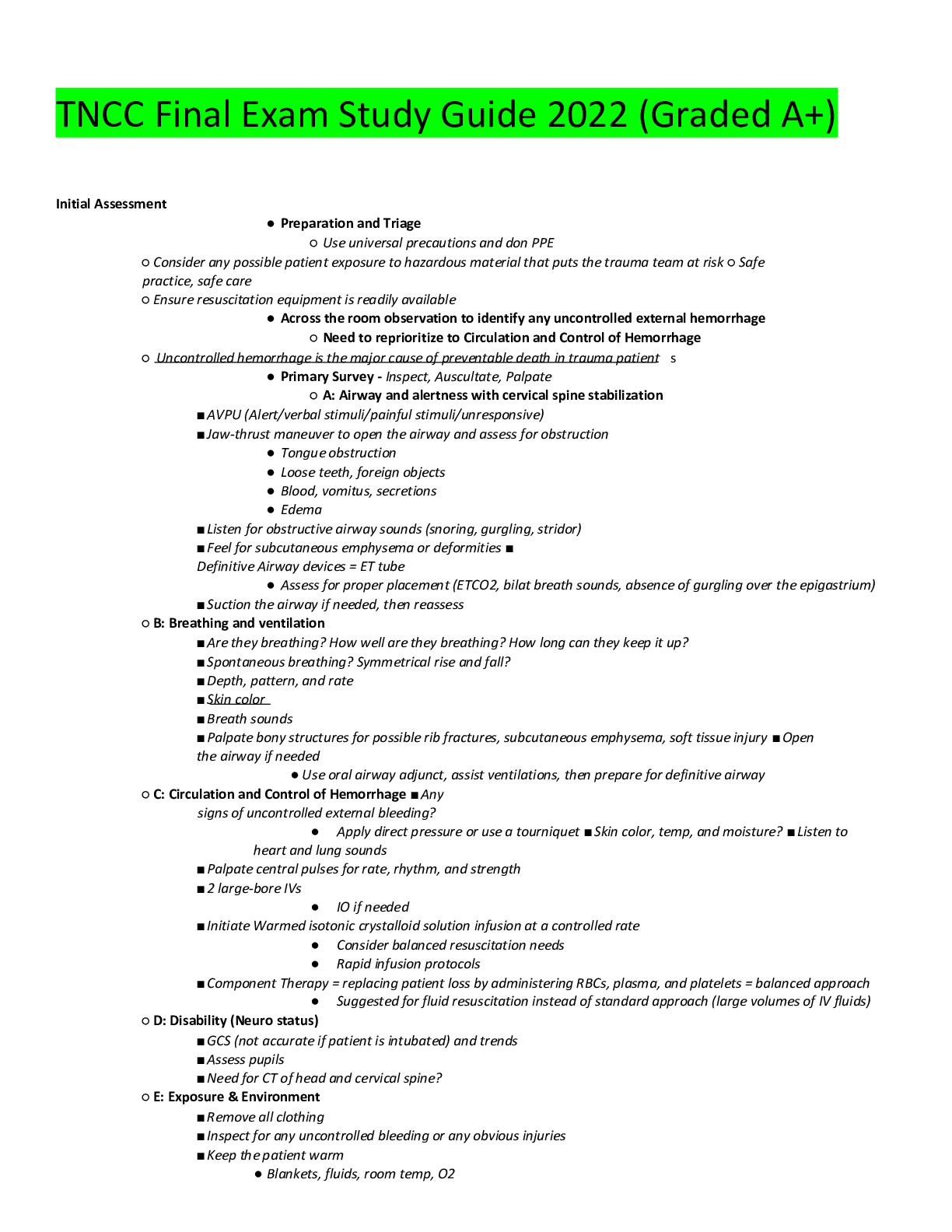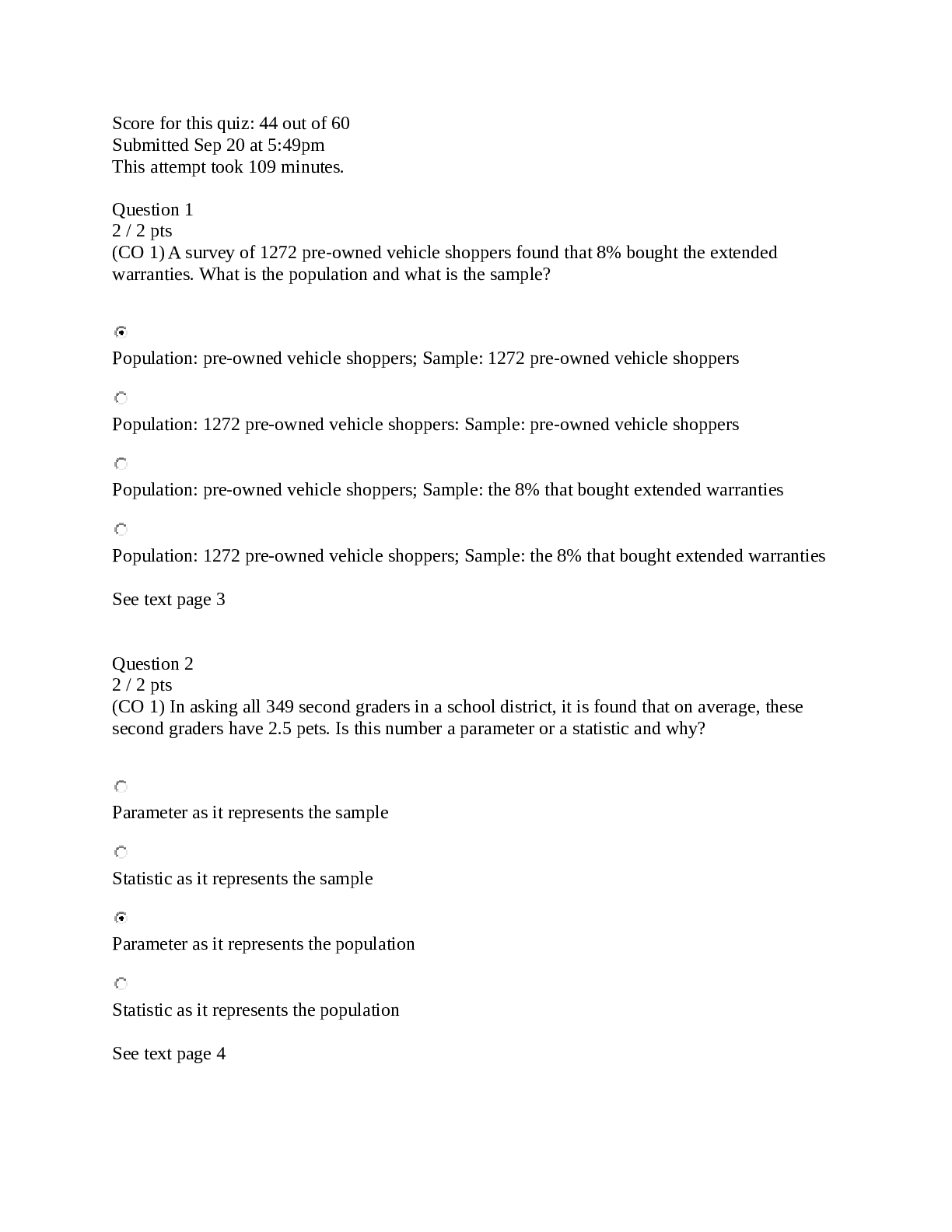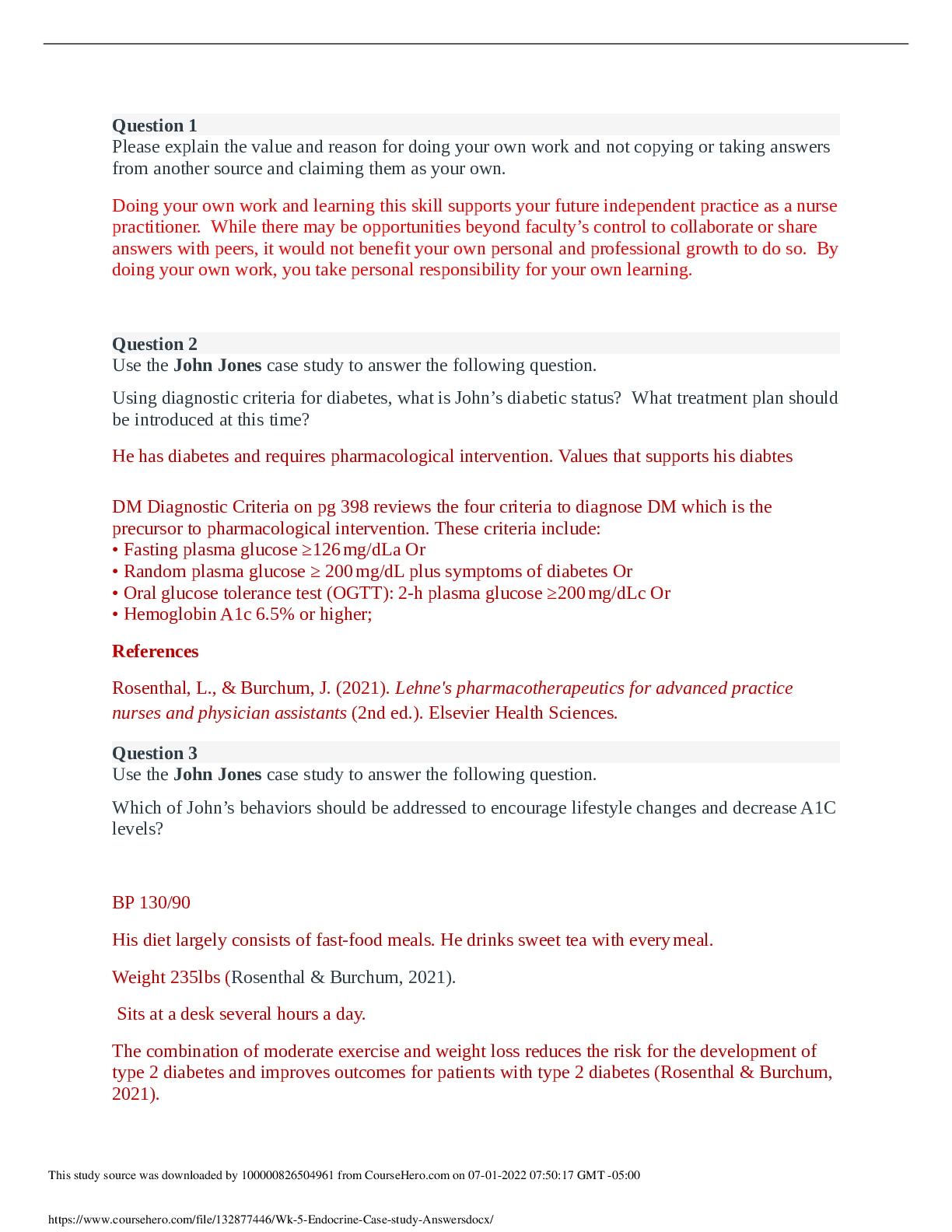Medical Studies > STUDY GUIDE > NASM Personal Training Certification Exam Questions with answers. 100% proven passing. Graded A+ (All)
NASM Personal Training Certification Exam Questions with answers. 100% proven passing. Graded A+
Document Content and Description Below
Muscle imbalances - ✔✔alteration of muscle length surrounding a joint Obesity - ✔✔The condition of being considerably overweight, and refers to a person with a body mass index of 30 or grea... ter, or who is at least 30 pounds over his or her recommended weight What is the BMI of a typical obese individual? - ✔✔30 or greater Refers to a person with a body mass index of 25-29.9 or who is between 25-30 pounds over the recommended weight - ✔✔overweight These are also known as cholesterol and triglycerides and are carried in the bloodstream by protein molecules known as HDL and LDL - ✔✔blood lipids chronic metabolic disorder caused by insulin deficiency, which impairs carbohydrate usage and enhances usage of fats and proteins - ✔✔diabetes mellitus a state of lost physical fitness, which may include muscle imbalances, decreased flexibility, and a lack of core and joint stability - ✔✔deconditioned the cumulative sensory input to the central nervous system from all mechanoreceptors that sense body positions and limb movement - ✔✔proprioception an unstable physical situation in which exercises are performed that cause the body to use its internal balance and stabilization mechanisms (Examples include using stability balls and single-leg squats versus traditional) - ✔✔proprioceptively enriched movement smaller divisions of training progressions that fall within the three building blocks of training - ✔✔phases of training a muscle's ability to contract for an extended period - ✔✔muscular endurance the ability of the neuromuscular system to enable all muscles to efficiently work together in all planes of motion - ✔✔neuromuscular efficiency What is the first phase of training that should be completed before anything else to prevent injury and/or tension at the joints? - ✔✔stabilization training the muscle that acts as the initial and main source of motive power - ✔✔prime mover set of two exercises that are performed back-to-back without any rest time between them - ✔✔superset What type of training should done by individuals with a goal of maximal muscle growth? - ✔✔Hypertrophy training ability of muscles to exert maximal force output in a minimal amount of time - ✔✔rate of force production the combination and interrelation of the nervous, muscular, and skeletal systems - ✔✔human movement systems a conglomeration of billions of cells specifically designed to provide a communication network within the human body - ✔✔nervous system the ability of the nervous system to sense changes in either the internal or external environment - ✔✔sensory function the ability of the nervous system to analyze and interpret sensory information to allow proper decision making, which produces the appropriate response - ✔✔integrative function the neuromuscular response to the sensory information - ✔✔motor function the functional unit of the nervous system - ✔✔neuron These neurons transmit nerve impulses from effector sites via receptors to the brain and spinal cord -- respond to touch, sound, light and other stimuli - ✔✔sensory neurons transmit nerve impulses from one neuron to another - ✔✔interneurons transmit nerve impulses from the brain and spinal cord to effector sites - ✔✔motor neurons the portion of the nervous system the consists of the brain and spinal cord - ✔✔central nervous system cranial and spinal nerves that spread throughout the body - ✔✔peripheral nervous system sensory receptors responsible for sensing distortion and pressure in body tissues - ✔✔mechanoreceptors receptors sensitive to change in length of the muscle and the rate of that change - ✔✔muscle spindles receptors sensitive to change in tension of the muscle and the rate of that change - ✔✔golgi tendon organs receptors surrounding a joint that respond to pressure, acceleration, and declaration of the joint - ✔✔joint receptors the body's framework, composed of bones and joints - ✔✔skeletal system provide a resting ground for muscles and protection of vital organs - ✔✔bones junctions of bones, muscles, and connective tissue at which movement occurs - ✔✔joints portion of the skeletal system that consists of the skull, rib cage, and vertebral column - ✔✔axial skeleton portion of the skeletal system that includes the upper and lower extremities - ✔✔appendicular skeleton The "link" between the axial and appendicular skeletons - ✔✔pelvic girdle the process of resorption and formation of bone - ✔✔remodeling a type of bone cell that removes bone tissue - ✔✔osteoclasts a type of cell that is responsible for bone formation - ✔✔osteoblasts the end of long bones, which is mainly composed of cancellous bone, and house much of the red marrow involved in red blood cell production - ✔✔epiphysis the shaft portion of a long bone - ✔✔diaphysis the region of a long bone connecting the diaphysis to the epiphysis -- a layer of cartilaginous cells in which growth in length of the diaphysis occurs - ✔✔epiphyseal plate a dense membrane composed of fibrous connective tissue that closely wraps all bone - ✔✔periosteum the central cavity of bone shafts where marrow is stored - ✔✔medullar cavity cartilage that covers the articular surfaces of bone - ✔✔articular cartilage flattened or indented portions of bone, which can be muscle attachment sites - ✔✔depressions projections protruding from the bone where muscles, tendons, and ligaments can attach - ✔✔processes a series of irregularly shaped bones called vertebrae that houses the spinal cord - ✔✔vertebral column 1st seven vertebrae starting at the top of the spinal column - ✔✔cervical spine twelve vertebrae located in the upper/middle back behind the ribs - ✔✔thoracic spine five vertebrae of the low back below the thoracic spine - ✔✔lumbar spine triangular bone located below the lumbar spine - ✔✔sacrum located below the sacrum, more commonly known as the tailbone - ✔✔coccyx more specific term for joint motion - ✔✔anthrokinematics joints that are held together by a joint capsule and ligaments and are most associated with movement in the body - ✔✔synovial joints this joint is a non-axial joint and is the simplest moving of all joints - ✔✔gliding joint these joints because the condyle of one bone fits into the cavity of another bone to form the joint - ✔✔condyloid joints uniaxial joint allowing movement predominantly in only the sagittal plane - ✔✔hinge joint this joint is only found in the carpometacarpal joint in the thumb, allowing movement in two planes of motion - ✔✔saddle joint these joints are found in the atlantoaxiao joint at the base of the skull and the radioulnar joint of the elbow, allowing movement in one plane of motion - ✔✔pivot joints these are the most mobile of all joints, allowing movement in all three planes - ✔✔ball-and-socket joints joints that do not have a joint cavity, connective tissue, or cartilage - ✔✔Nonsynovial joint primary connective tissue that connects bones together and provides stability, input to the nervous system, guidance, and the limitation of improper joint movement - ✔✔ligament What is the best type of exercise for bone strength and health? - ✔✔weight-bearing exercise series of muscles that moves the skeleton - ✔✔muscular system a layer of connective tissue that surrounds the muscle - ✔✔epimysium the connective tissue that surrounds fascicles - ✔✔perimysium the deepest layer of connective tissue that surrounds individual muscle fibers - ✔✔endomysium connective tissue that attach muscle to bone and provide as an anchor for muscles to produce force - ✔✔tendons the functional unit of a muscle that produces muscular contraction and consists of repeating sections of actin and myosin - ✔✔sarcomere the contraction of a muscle generated by neural stimulation - ✔✔neural activation a motor neuron and all of the muscle fibers that it activates - ✔✔motor unit chemical messengers that cross the neuromuscular junction the transmit impulses from nerve to muscle - ✔✔neurotransmitters Type 1 muscle fibers, also known as _________________ muscle fibers have a high oxidative capacity and don't fatigue as easily - ✔✔slow-twitch Type 2 muscle fibers, also known as _________________ muscle fibers have a low oxidative capacity and fatigue easily - ✔✔fast-twitch these hormones help prepare the body for activity and are participants in the "fight or flight" reflex - ✔✔catecholamines [Show More]
Last updated: 2 years ago
Preview 1 out of 24 pages
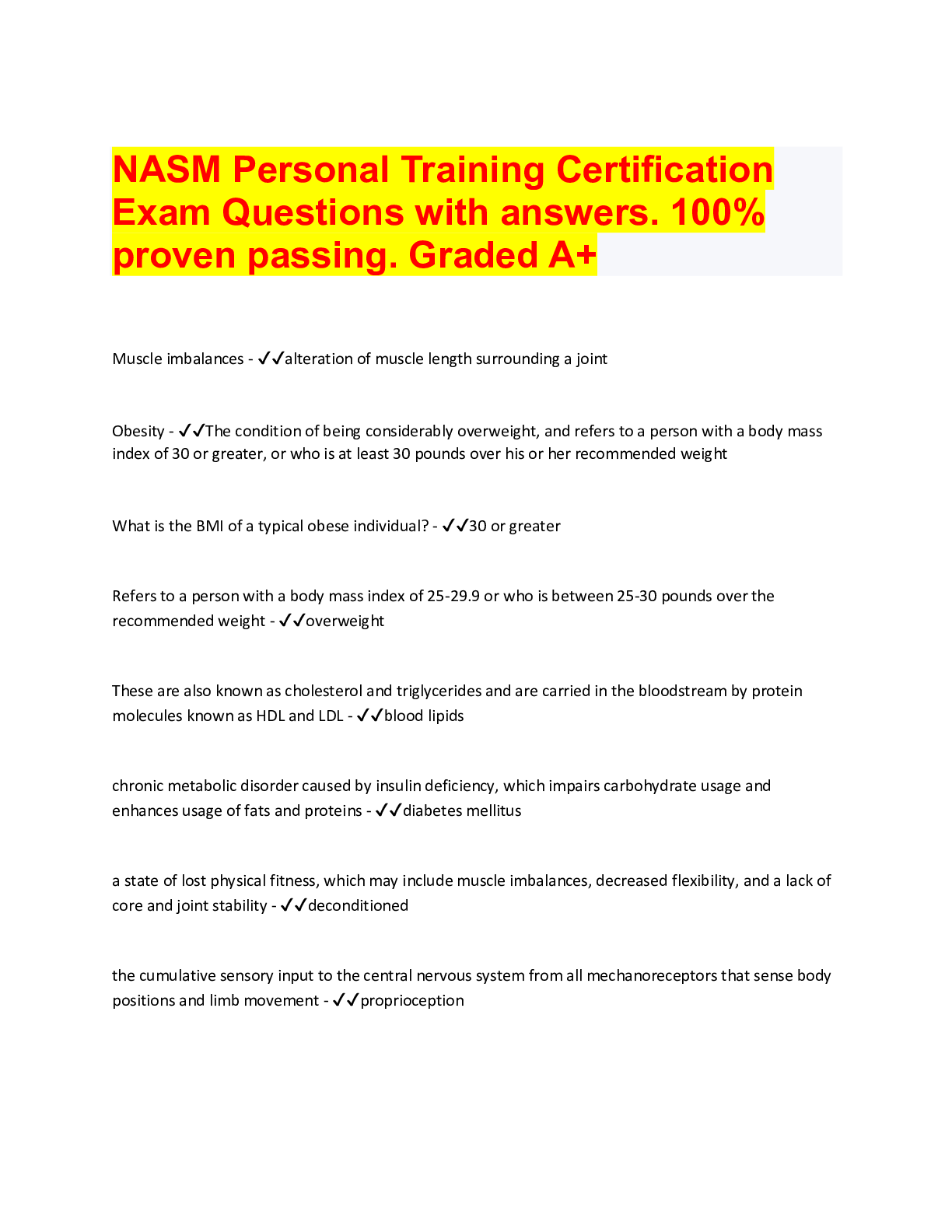
Buy this document to get the full access instantly
Instant Download Access after purchase
Buy NowInstant download
We Accept:

Also available in bundle (1)

NASM bundle, latest 2022 exam predictors
All you need to pass the NASM exam, Rated A+. download to score
By bundleHub Solution guider 2 years ago
$30
9
Reviews( 0 )
$8.00
Can't find what you want? Try our AI powered Search
Document information
Connected school, study & course
About the document
Uploaded On
Aug 15, 2022
Number of pages
24
Written in
Seller

Reviews Received
Additional information
This document has been written for:
Uploaded
Aug 15, 2022
Downloads
0
Views
145




